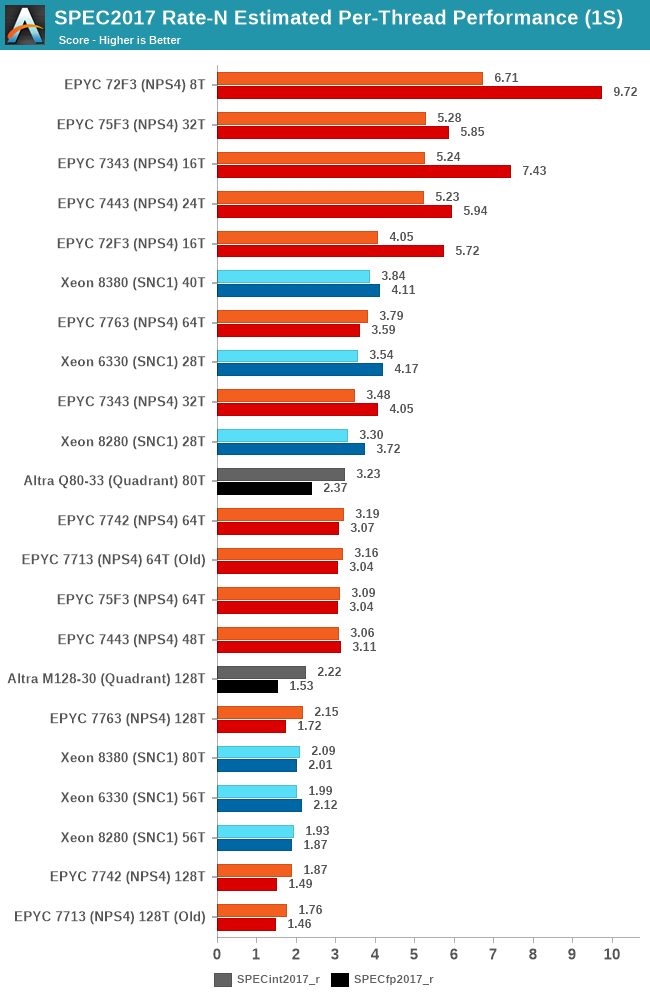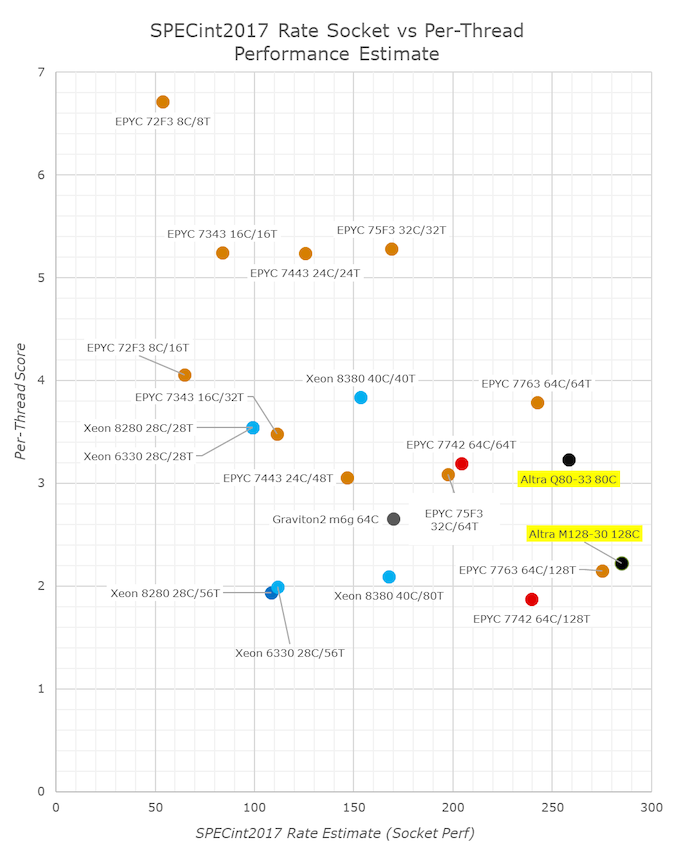The Ampere Altra Max Review: Pushing it to 128 Cores per Socket
by Andrei Frumusanu on October 7, 2021 8:00 AM EST- Posted in
- Servers
- Arm
- Neoverse N1
- Ampere
- Altra Max
SPEC - Per-Core Performance under Load
A metric that is actually more interesting than isolated single-thread performance, is actually per-thread performance in a fully loaded system. This actually is a measurement and benchmark figure that would greatly interest enterprises and customers which are running software or workloads that are possibly licensed on a per-core basis, or simply workloads that require a certain level of per-thread service level agreement in terms of performance.
The Altra Max here is inevitably expected to post worse metrics than the Altra – first of all due to the 10% lower core frequencies, and second of all due to lower shared resources that need to be shared amongst more cores.

As expected, taking view of the aggregate socket performance figures here, the M128-80 doesn’t fare well here in the metric, as it takes the much controversial “flock of chickens” approach to core performance. It’s also dragged down by the score regressions in the memory bound workload in SPEC.
In terms of total throughput vs per-thread performance, the M128-30 barely differs to the EPYC 7763 with SMT and half the physical cores.
Again, I have to reiterate that these figures are all very much not in favour of the workloads that the Altra Max was designed for – cloud and hyperscaler workloads, which don’t tend to have the same harsher memory demands as some of the workloads in the SPEC suite. However, extracting those workloads in a different subset would also be a questionable practise and actually frowned upon.
The Altra Max here really does need to have huge footnotes in the way that it presents itself.











60 Comments
View All Comments
mode_13h - Thursday, October 7, 2021 - link
> x86 still commands 99% of the server market.Depends on what you consider the "server market", but AWS is very rapidly switching over. Others will follow.
Lots of cloud compute just depends on density and power-efficiency. And here's where ARM has a real advantage.
Wilco1 - Thursday, October 7, 2021 - link
According to https://www.itjungle.com/2021/09/13/the-cacophony-... Arm server revenue has been 4-5% over the last few quarters.schujj07 - Friday, October 8, 2021 - link
Anything under 10% market share in the server world is basically considered a niche player. Right now AMD is over 10% so they are finally seen as an actual player in the market.Spunjji - Friday, October 8, 2021 - link
Pointing at current market share that resulted from a lack of viable ARM competition isn't a great argument for your prediction that ARM will not gain market share, especially when you're being presented with evidence of viable ARM competition.mode_13h - Thursday, October 7, 2021 - link
> Before AMD can disrupt Intel in the server,*before* ? This is already happening! You can clearly see it in AMD's server marketshare, as well as the price structure of Ice Lake.
> And now Intel is coming back with Saphire Rapids. Doesn't look good for AMD.
AMD has Genoa, V-Cache, and who knows what else in the pipeline. Oh, and they can also build an ARM core just as good as anyone (with the possible exceptions of Apple and Nuvia/Qualcomm).
yetanotherhuman - Friday, October 8, 2021 - link
Not even in slight agreement. Different architecture.eastcoast_pete - Thursday, October 7, 2021 - link
Thanks Andrei, great analysis! IMO, the biggest problem Ampere and other firms that develop server CPUs based on ARM designs is that their natural customers - large, cloud-type providers - pretty much all have their own, in-house designed ARM-based CPUs, and won't buy thousands of third party CPUs unless they do something their own can't do, or nowhere near as well. AWS, Google, MS, and Apple still buy x86 CPUs from Intel or AMD because there is a customer demand for those instances, but also try to shift as much as they can to their own, home-grown ARM server systems. In this regard, has anyone heard any updates about the ARM designs supposedly in development at MS? Maybe Ampere can get themselves bought out by them?name99 - Friday, October 8, 2021 - link
“own house-designed ARM-based CPU’s”?We obviously have Graviton. Apple seem a reasonable bet at some point. Maybe a large Chinese player.
Do we have any evidence (as opposed to hypotheses and rumors) of Google, Facebook, Microsoft, or most of China? Or other smaller but still large players like Yandex or Cloudflare?
Sivar - Thursday, October 7, 2021 - link
This is a proper old-school deep CPU review.vegemeister - Thursday, October 7, 2021 - link
Text says Intel Xeon 8380 is running at 205 W power limit, but the table says 270 W. Which is it? I assume 270 W like ARK says?